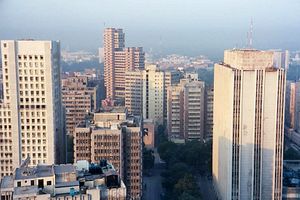The end of February saw the release of another round of disappointing figures on India’s economy. In the final quarter of 2013, India’s economy grew by 4.7 percent, the fifth consecutive quarter of sub-5 percent growth. Compared with the ailing economics of Europe, India’s growth rate appears positively bullish. But 4.7 percent is far below the 8 percent growth rate that India’s government says it needs to combat the country’s chronic development challenges. As India heads towards a landmark election – in which the government will almost certainly change hands – this dire economic performance casts a long shadow.
The incumbent UPA government, a coalition of left-leaning parties, has long championed an “inclusive” growth model. But its failure to ensure that the benefits of growth have “trickled down” to the poor is well established. When adjusted for variations in the cost of living, 32.7 percent of India’s population live below the international extreme poverty line of $1.25 per day. India is home to a third of the world’s poor, a third of the world’s slave population, and on a host of other social and development indicators it continues to slip further and further behind other developing countries.
Poverty lines are not entirely reliable measures of deprivation, instead they allow for long-term trends to be traced. According to figures compiled by the World Bank and McKinsey, since the 1980s India has only lifted 35 million people out of extreme poverty. In China the figure is 678 million. India’s poor poverty-reduction rate is matched by rapid increases in income inequality. In January India’s Business Standard reported income inequality in urban areas across a third of India’s states reached its highest point in 2011-12 since 1973-74.
In theory widening gaps between the rich and the poor should encourage the latter to innovate and compete and because of this, economists have tended to neglect it as a developmental concern. But this is now changing. As Christine Lagarde, chairperson of the International Monetary Fund said last month in a speech to the World Economic Forum that inequality “harms the pace and sustainability of growth over the long term.”
The widening gap in income levels in urban areas is the product of a number of factors: continued rural-to-urban migration, a contracting industrial sector and a growing under-skilled labor force. India is urbanizing rapidly, with the urban population set to increase from 27.8 percent in 2011 to 38 percent by 2025. The country’s shrinking manufacturing sector has not been able to absorb this migrant labor force, exacerbating the problems of urban unemployment, slum expansion and widening income inequality. These challenges have had a long gestation, and persistent policy neglect is to blame. As the Indian Express complained in a recent op-ed, “The political class, across the ideological divide, continues to be evasive in addressing the legitimate needs of a fast growing urban India.”
Manufacturing has the potential to be an engine of growth and development. India’s Finance Minister said as much in his valedictory budget speech early last month, when he described Indian industry as the country’s economic “Achilles’ heel.” But the country’s manufacturing sector continues to be hobbled by poor electrification, a shortage of skilled workers and inflexible hiring-and-firing practices.
Improving public services, reforming labor regulations and boosting infrastructure are three things the World Bank has consistently called for, each of which is central to India’s effort to tackle poverty, boost employment and revive industry.
Until then India is witnessing the curious phenomenon of “reverse migration”: due to the lack of manufacturing jobs, 12 million people are set to return to rural areas from cities by 2019. These estimates, produced by Crisil, an Indian research institute, also show that the rate of job creation across both industry and agriculture is declining.
India is famously enjoying a demographic divided: it has a growing population with millions more entering the labor force each year than are leaving it. With a median age of 26 and with almost two-thirds of the population under 35, India is well placed to compete with the aging populations of its Asian economic rivals China and Japan. But India’s vast stock of labour is being squandered by a shortage of jobs, a stumbling manufacturing sector and desperate skill deficits – challenges with serious implications for urban India.
































